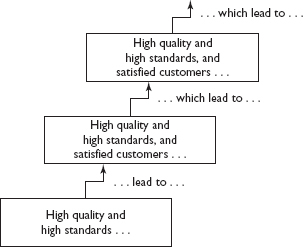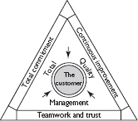Session B
Towards total quality
 1 Introduction
1 Introduction
‘In quality management these are the Absolutes: Quality means conformance to requirements; Quality is obtained through prevention; Quality has a performance standard of zero defects; Quality is measured by the price of nonconformance.’
– Philip B. Crosby, Quality is Still Free, McGraw-Hill, 1996
‘In the future there will be two kinds of company – those who have implemented Total Quality and those who have gone out of business. You do not have to do this – survival is not compulsory.’
– Dr W. Edwards Deming
| EXTENSION 1 The many aspects of total quality management are discussed in the book Total Quality Management by John S. Oakland | In the last 20 years or so, many organizations began to adopt a new approach to quality management. This approach is a result of the increasing emphasis on the importance of quality in products and services. It acknowledges that: |
![]() it is not enough to verify that products comply with requirements (inspection and quality control);
it is not enough to verify that products comply with requirements (inspection and quality control);
![]() neither is it enough to install adequate quality systems to ensure that products are made to requirements (quality assurance).
neither is it enough to install adequate quality systems to ensure that products are made to requirements (quality assurance).
If an organization wants to ensure the quality of its products, it has to ensure the quality of all the designs and processes that are used to make those products. This means that every person and every activity in an organization becomes involved in quality.
It is this exciting perspective on quality that we look at in this session of the workbook.
 2 The traditional approach to
2 The traditional approach to
quality management
Until quite recently – the last 20 or 25 years – the management of a typical organization’s quality system was assigned to one department and one manager. The quality assurance manager was held to be responsible for the quality of all goods and services. A commonly held view was that quality was something you ‘added on’ or ‘inspected into’ the organization’s products, and that it was the quality manager’s job to see that this was done.
While the chief executives of many companies would spend hours discussing finance or marketing, which they saw as being key to the organization’s success, quality was largely ignored until customers complained about it. And when this happened, the quality manager would be chastised, and told to ‘sort out the problem’. Philip Crosby says in his book Quality is Still Free:
‘… as I learned more about managing quality, I realized that the conventional approach was not effective. Quality managers proudly stood up and announced that they personally were responsible for quality in a particular operation. Just as regularly, and not so proudly, they were sent down in flames when they were unable to resolve all the “quality problems” of the company.
As a project quality manager, I was berated each week by the program director in his staff meeting for not meeting desired goals while the real culprits from engineering, manufacturing, and sales hid their yawns and wished the whole thing would go away so they could return to their important work.’
Crosby and many others were appalled by these traditional methods and attitudes, not least because they promoted a system that plainly didn’t work very well. As we have already discussed, getting the quality right is the only way for a company to be successful. And to do that, a whole new approach is required.
Quality management has to:
![]() be led from the top;
be led from the top;
![]() involve everyone in the organization;
involve everyone in the organization;
![]() be recognized as being vitally important.
be recognized as being vitally important.
This ‘new thinking’ led to total quality management.
 3 What is total quality management?
3 What is total quality management?
We mentioned the term total quality management (TQM) in the last session, and you may well have heard it talked about. But what is it?
Like other aspects of quality, TQM is, to some extent, open to interpretation. It has been described as a philosophy of quality that links policy and operational practice.
Some people would say that TQM is more than a philosophy: it is a way of life.
From another point of view, total quality management is a natural extension and development of quality systems – quality assurance and quality control – to cover all aspects, areas and people of an organization.
The three words ‘total quality management’ can be said to represent three elements. TQM:
|
Key concepts, central to TQM, are:
|
(In case you have not come across the term ‘empowerment’ before, we will discuss it in Session C.)
A good definition of TQM would therefore be as follows.
Total quality management involves every member of the organization in a process of continuous improvement with the aim of satisfying the customers’ wants and expectations.
Activity 16

We have discussed reasons why an organization should be totally committed to quality. But not everyone agrees: some people think that the idea of TQM has been oversold. Write down what you think their main argument would be.
You may put up the argument used by one company executive when attending a lecture on TQM.
‘Why all this fuss about quality? Business is about survival – it’s a competitive world. As a company, we can’t afford to set ourselves ideals – we have to work to realities. Our quality is no worse than anyone else’s. In any case, customers don’t expect miracles – they want a reasonable package for a reasonable price.’
A response to this would be as follows.
‘It is certainly a competitive world. Competition is the main driving force behind quality. But an organization needs to be better than the competition. To do that it has to go on improving – or else get left behind. And to do that an organization needs total commitment.’
Another response is that customers are becoming more sophisticated and are tending to expect more for their money. They want that ‘extra something’, and if they think they can get it they will become dissatisfied with anything less. In fact, it has been said that
customers want more than to be satisfied – they want to be delighted!
To ‘delight’ customers, they have to be given more than they expect.
Here is another argument against TQM.
‘Quality is not a philosophy, it’s about giving the customers what they want. That means that you have to check everything carefully. Getting quality right is attention to detail, not high-flown theories.’
‘Quality does not come about as the result of some particular way of dancing’. – Philip Crosby |
Many would agree with this. Getting quality right is certainly all about attention to detail, as we will shortly discuss. And there’s no harm in being sceptical about any theory if you find it unconvincing. Now let’s look at some of the aspects of the TQM model. |
 4 Continuous improvement
4 Continuous improvement
|
‘… advocates of improvement, or kaizen, see striving for quality as an endless journey rather than a trip to a known and fixed destination.’ – John Naylor (1995), Operations Management, Pitman Continuous improvement is often referred to by its Japanese name, kaizen. It is characterized by: |
![]() a large number of detailed improvements;
a large number of detailed improvements;
![]() over a long period of time;
over a long period of time;
![]() involving teams throughout the organization.
involving teams throughout the organization.
The accumulation of these small increments brings about large-scale advantages to the organization.
According to the philosophy of kaizen, everyone has two parts to his or her job:
![]() continuation: following current standards and practice;
continuation: following current standards and practice;
![]() improvement: searching for higher standards and better ways of doing the work.
improvement: searching for higher standards and better ways of doing the work.
Examples of individual improvements are:
![]() reducing the amount of waste when cutting out patterns;
reducing the amount of waste when cutting out patterns;
![]() taking less time to set up a machine;
taking less time to set up a machine;
![]() eliminating an unnecessary form to reduce time and effort spent on administration;
eliminating an unnecessary form to reduce time and effort spent on administration;
![]() finding an improved method of marking prices on goods.
finding an improved method of marking prices on goods.
The attention is on the detail. Continuous improvement is not simply a vague notion implying good intentions: it is about achieving real and lasting improvements at every stage. This can only be done through hard work, as Philip Crosby says in his book Quality is Still Free.
‘People get angelic looks on their faces when they talk about continuous improvement. There are actually two different concepts involved. First is the popular one that says it is okay to drop six babies this week as long as we only plan to drop five next week. The second is that once we learn how to do things right, we are going to learn to get better all the time. Very few like the second. It is a lot of work.’
 5 Focus on the customer
5 Focus on the customer
|
It has been said that the best way to recognize a total quality organization is to watch how it deals with its customers. We’ve all had experience of poor quality products and services. You go into a shop, ready to spend your money, and the shop assistants ignore you. You take your car to a garage to get it repaired, and after you’ve paid the bill are annoyed to find that the car still has the fault. You buy an expensive item of furniture and discover that the quality of finish is pretty dreadful. Or you stand in a queue for half an hour, only to find yourself face to face with a sour-faced and unhelpful counter clerk. |
Activity 17

Describe how you feel when you are on the receiving end of poor quality products or services. (Just one sentence will do!)
Now say how you are likely to act when you experience excellent quality – when you find yourself delighted by the services or goods you buy.
It may be that you felt you could sum up your feelings about poor quality in one word – ‘terrible!’ perhaps. You may also agree that when they buy inferior quality products, or receive bad service, most people tend to react by going somewhere else in future. It is estimated that up to 96 per cent of unhappy customers do not complain to the supplier, but these same people are very likely to convey their bad experiences to other potential customers.
What about the opposite kind of experience? If you are actually delighted by the quality of your purchase, you are surely much more inclined to go back to the same supplier for your next purchase.
Successful commercial organizations recognize that building up customer loyalty has to be a key element in their marketing strategy. How can this be done? Some of the ways are in:
![]() delivering a level of quality that is consistently high;
delivering a level of quality that is consistently high;
![]() putting the wants and expectations of the customer first – for without customers there is no business;
putting the wants and expectations of the customer first – for without customers there is no business;
![]() establishing a culture in which all employees are expected to display a commitment to the customer.
establishing a culture in which all employees are expected to display a commitment to the customer.
5.1 Quality and internal customers
You may not work in direct contact with the organization’s customers – the people who buy the products.
But everybody in the organization has a customer. Whoever is the next person or group to benefit from the work you do is your customer.
For example:
![]() the customers of the office cleaner are the people who work in the office;
the customers of the office cleaner are the people who work in the office;
![]() the customers of a team making printed circuits are the team whose job it is to place those printed circuits in larger assemblies;
the customers of a team making printed circuits are the team whose job it is to place those printed circuits in larger assemblies;
![]() the teachers and pupils in a school are the customers of the lab technicians, to whom they provide a service;
the teachers and pupils in a school are the customers of the lab technicians, to whom they provide a service;
![]() the customers of a payroll clerk are the employees whose wages he or she calculates.
the customers of a payroll clerk are the employees whose wages he or she calculates.
Everyone in the workplace has customers.
Let’s look at an example of what the effects can be when internal customers are not satisfied.
Imagine a large corporation with a wide range of services and products. Somewhere tucked away in just one of the corporation’s many factories, there is a team, and part of its job is to collect and dispose of the kitchen waste from the factory’s several canteens.
Not a very important task, you might say. Certainly not a very visible one, from the point of view of the corporation’s external customers. Only employees eat in the canteen, not customers. And the average employee eating his or her lunch doesn’t give a moment’s thought to the job of clearing away kitchen waste.
Activity 18

Who might be the ‘customers’ of the waste-disposal team?
How can the work that this team does have any possible effect on the prosperity of the organization?
The team’s immediate customers might be the kitchen supervisors.
Let’s think what might happen if the team does not satisfy their customers.
Suppose they do a less than good job – perhaps waste is left in and around the kitchens for much longer than it should be, for example. There are several possible consequences of the poor quality of their work, including the following.
![]() Uncollected waste will probably encourage bacteria and vermin, which may in turn endanger the health of the kitchen staff and the employees eating food from the kitchens; in the worst case, the resultant illness and absenteeism could directly affect the corporation’s profits.
Uncollected waste will probably encourage bacteria and vermin, which may in turn endanger the health of the kitchen staff and the employees eating food from the kitchens; in the worst case, the resultant illness and absenteeism could directly affect the corporation’s profits.
![]() The kitchen staff may become accustomed to seeing waste lying about. This could easily make them feel that ‘sloppy’ standards of work are acceptable. They in turn may do less than their best, and so will probably make their customers dissatisfied.
The kitchen staff may become accustomed to seeing waste lying about. This could easily make them feel that ‘sloppy’ standards of work are acceptable. They in turn may do less than their best, and so will probably make their customers dissatisfied.
![]() The kitchen supervisors, struggling to do a good job, may become frustrated with the service they are getting. If nothing is done about the problem, some may even want to leave. If they do, the corporation will need to pay out more for recruitment and training.
The kitchen supervisors, struggling to do a good job, may become frustrated with the service they are getting. If nothing is done about the problem, some may even want to leave. If they do, the corporation will need to pay out more for recruitment and training.
You can see that there is a kind of chain reaction taking place.

If the final customer doesn’t suffer, the organization certainly will, and so will its employees.
Now let’s look on the positive side. The chain works the other way, too. High quality work – whatever it is – nearly always results in:
![]() happy and satisfied customers (whether internal or external);
happy and satisfied customers (whether internal or external);
![]() the setting of higher standards, which others tend to follow;
the setting of higher standards, which others tend to follow;
![]() more satisfied employees – because everyone gets more satisfaction from doing a good job than doing a bad one;
more satisfied employees – because everyone gets more satisfaction from doing a good job than doing a bad one;
![]() a more successful organization.
a more successful organization.
This idea is shown in the diagram below.
In the Work-based assignment for this workbook, you will be asked to identify your team’s internal customers, and to identify ways of improving your service to them. |
 |
 6 A commitment to quality
6 A commitment to quality
 |
Total quality management, more than anything, demands a total commitment to quality on behalf of everyone involved. To achieve the aim of ‘continuous improvement towards perfection’, the whole organization has to be geared towards quality. An essential concept of TQM is that: |
every person and every group is involved in quality.
This means that quality concerns:
|
|
but also in:
|
But how do you maintain people’s commitment to a quality programme? Many programmes have failed, not because the fundamental ideas were wrong, or because initial enthusiasm was lacking, but that:
maintaining a commitment to quality is far more difficult than getting started.
Three essential management tools for maintaining commitment are:
![]() consistency: in other words, meaning what you say, without allowing yourself to lose sight of the overall goals;
consistency: in other words, meaning what you say, without allowing yourself to lose sight of the overall goals;
![]() communications: saying what you mean, and being willing to share information;
communications: saying what you mean, and being willing to share information;
![]() involvement: allowing every member of the team to participate fully.
involvement: allowing every member of the team to participate fully.
6.1 Being consistent
| EXTENSION 3 The leadership aspects of quality management are dealt with in Juran on Leadership for Quality, by Joseph M. Juran. The book is listed on page 89. |
When TQM is introduced, it entails a change of attitude and approach on the part of everyone. When people are asked to participate actively in such a programme, they will naturally look to managers for leadership. A certain amount of scepticism can be expected. |
Activity 19

What kinds of questions are likely to form in the minds of staff when an initiative such as TQM is introduced? Think about your own team, and the questions they might ask themselves, especially about management’s intentions. Jot down two questions.
Typically, people will ask themselves questions similar to the following.
‘We hear the words, but does management mean what it says?’
‘Who will be rewarded – those who stick to the old rules, or those who try to live up to the new ideals, and inevitably make mistakes?’
‘When things get difficult, will management hastily revert to a policy of making the best of things, or will it remain true to the TQM concepts?’
In other words, among other things, staff will look to management for consistency in their application of the new system.
6.2 Communicating
To become committed to the TQM cause, and to remain so, people will want lots of information. They will need to:
![]() be trained in the concepts of TQM, and how they should be applied;
be trained in the concepts of TQM, and how they should be applied;
![]() be reminded at frequent intervals about these concepts;
be reminded at frequent intervals about these concepts;
![]() be guided in adapting their behaviour;
be guided in adapting their behaviour;
![]() have feedback on their performance;
have feedback on their performance;
![]() be told how the customers are reacting to the new approach;
be told how the customers are reacting to the new approach;
![]() be informed about progress, locally and in the organization as a whole.
be informed about progress, locally and in the organization as a whole.
 7 Teamwork and trust
7 Teamwork and trust
 |
TQM will only work if there is complete commitment, not only by management, but by everyone in the organization. No single person or department can make TQM operate successfully: it needs the full co-operation of all staff and all departments. That’s why teamwork and mutual trust are essential ingredients in the TQM recipe. We will take up these topics again in the next session, and deal more fully with the ‘teamwork and trust’ dimension of total quality management. |
Self-assessment 2

1 What are the characteristics of continuous improvement (kaizen)?
2 Write down a definition of total quality management.
3 What would you say to someone in your organization who claimed: ‘I don’t have customers – I just get on with my job, by obeying instructions.’
4 Complete the words and phrases in the following diagram.

Answers to these questions can be found on pages 93–4.
8 Summary
![]() The traditional view of quality management was that it was something that one of the organization’s departments did, and that quality problems could be blamed on the quality manager.
The traditional view of quality management was that it was something that one of the organization’s departments did, and that quality problems could be blamed on the quality manager.
![]() Total quality management (TQM) involves every member of the organization in a process of continuous improvement with the aim of satisfying the customers’ wants and expectations.
Total quality management (TQM) involves every member of the organization in a process of continuous improvement with the aim of satisfying the customers’ wants and expectations.
![]() Customers want more than to be satisfied – they want to be delighted! In order to ‘delight’ customers, you have to give them more than they expect.
Customers want more than to be satisfied – they want to be delighted! In order to ‘delight’ customers, you have to give them more than they expect.
![]() There are three key elements to TQM:
There are three key elements to TQM:
![]() continuous improvement;
continuous improvement;
![]() teamwork, involving trust and empowerment;
teamwork, involving trust and empowerment;
![]() focusing on the customer’s wants and expectations.
focusing on the customer’s wants and expectations.
![]() Continuous improvement is often referred to by its Japanese name kaizen. It is characterized by:
Continuous improvement is often referred to by its Japanese name kaizen. It is characterized by:
![]() a large number of detailed improvements,
a large number of detailed improvements,
![]() over a long period of time,
over a long period of time,
![]() involving teams throughout the organization.
involving teams throughout the organization.
![]() Successful commercial organizations recognize that building up customer loyalty has to be a key element in their marketing strategy. This can be done by:
Successful commercial organizations recognize that building up customer loyalty has to be a key element in their marketing strategy. This can be done by:
![]() delivering a level of quality that is consistently high;
delivering a level of quality that is consistently high;
![]() putting the wants and expectations of the customer first – for without customers there is no business;
putting the wants and expectations of the customer first – for without customers there is no business;
![]() establishing a culture in which all employees are expected to display a commitment to the customer.
establishing a culture in which all employees are expected to display a commitment to the customer.
![]() Everyone in the workplace has customers. Internal customers are nearly as important as external ones.
Everyone in the workplace has customers. Internal customers are nearly as important as external ones.
![]() Three essential management tools for maintaining commitment are:
Three essential management tools for maintaining commitment are:
![]() consistency: meaning what you say, without allowing yourself to lose sight of the overall goals;
consistency: meaning what you say, without allowing yourself to lose sight of the overall goals;
![]() communications: saying what you mean, and being willing to share information;
communications: saying what you mean, and being willing to share information;
![]() involvement: allowing every member of the team to participate fully.
involvement: allowing every member of the team to participate fully.
